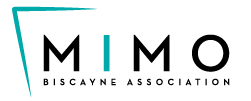MIMO NEON
written by Debby Stander
According to an April 1954 article in the Miami Daily News, a new trend in tourism had taken South Florida by storm. New motels were being opened in the area at the rate of one every two weeks. Biscayne Boulevard, the gateway to the Magic City, was an attractive address for the new motor lodges. Their names catered to the fantasies of the urban nomad: Shalimar. South Pacific. Vagabond. Sinbad. Saturn. 7 Seas. Along with the names, eye-catching signs were needed to attract the attention of drivers. Neon tubing, with its glowing colors and ability to be bent to any shape, provided the perfect solution.
The first use of neon as a form of luminescent tube lighting was patented by the Frenchman Georges Claude in 1910. Claude discovered that when an electric current was run through neon gas in a closed glass tube it created a beautiful colored light. He obtained a U.S. patent for his invention in 1915 but it was not till 1923 that Claude Neon Lights, Inc. sold its first neon signs and set up its first franchises in the U.S. Claude’s strict patent enforcement policy was eventually overtaken by advances in technology, paving the way for widespread use of neon in outdoor lighting. By the 1960s, however, neon’s heyday had run its course and it was replaced by the cheaper fluorescent-lamp, backlit, plastic box sign.
In recent years there has been renewed appreciation for the vanishing art of neon sign fabrication. Old signs are sought after by collectors and neon museums have opened in several cities.
MiMo’s neon signs have not been immune to the march of time. Some were lost to the wrecking ball prior to historic designation of the district. Others, like the Sinbad’s signs, suffered deterioration and had to be re-colored. Originally red, the Sinbad’s signs are now pink, yellow and blue, though tubing and lettering are still all original. Elsewhere in the district letters have been modified to reflect name changes. The Motel New Yorker is now the Hotel New Yorker. The Motel South Pacific will become the Wotel South Pacific — it‘s original “M“ turned upside down to reflect its projected use as motel/retail/office space. The Shalimar is missing one of its original two beautiful corner signs. Lights are partially out at some locations. Happily, at the Vagabond, signs have been restored by Hialeah-based Neon Sign Solutions, Inc. (NSSI) to their full former glory. NSSI has also been charged with comprehensive restoration of the South Pacific’s striking neon signage in tandem with the overall restoration of the building.
Regardless of their current status, all of the signs are visually stunning. A visit to MiMo after dark will reward anyone who appreciates these evocative colored lights and the historic architecture they helped define.
